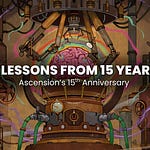About Neeraj Kashyap
Neeraj Kashyap, a pioneer in the blockchain gaming sector, joins us to share his journey from academia to the forefront of Web3 game development. As the founder and CEO of Moonstream.to, Neeraj leverages his Master of Science in Applied Mathematics and a PhD in Number Theory from Indiana University to design games for the blockchain. His company has not only launched over five games exclusively on the blockchain but has also guided many others in making their mark within the Web3 gaming landscape. In our conversation, Neeraj will offer insights into the challenges and potential of blockchain in gaming, discussing how it can create more immersive and ownership-driven experiences. Tune in to explore the cutting-edge intersection of game design and blockchain technology with one of its most innovative thinkers.
For more on this topic you can also check out my article on Web3 Gaming:
Ah-ha! Justin’s Takeaways
Engagement-Driven Economies: Whether on-chain or off-chain, all elements like virtual currencies, digital cookies, or in-game resources should enhance player engagement. Designing these economies is a complex process that requires the same level of care and iteration as the core gameplay itself to ensure that players are continuously drawn into an enjoyable experience.
Prioritize Fun: Many pyramid scheme-like models in web3 originate from studios that prioritize profit over entertainment. For a game economy to be sustainable, it must be rooted in a fundamentally enjoyable game. Even in this space, the core game design principle applies: “The most important metric is player experience.” This might seem obvious, but it is surprisingly uncommon in the early stages of the crypto gaming space.
Meaningful Player Ownership: Players desire more than just ownership of in-game objects; they want to feel a connection to the games themselves, akin to how personal a favorite game can become, as experienced during my days playing Magic. When structured properly, web3 games can offer both emotional and material benefits, rewarding players for their involvement, contributions, and efforts in expanding the games they cherish.
Want to support the podcast and get more design lessons?
Paying subscribers enjoy an abundance of extra game design content and an exclusive newsletter with new lessons, archive access, videos, and more! By opting for a free or paid subscription, you can get the latest articles delivered to your inbox and support this podcast!
Show Notes
“I see the potential in decentralization, and I really believe in it.” (00:00)
Neeraj begins by describing his journey into the gaming world, starting with his experiences playing backgammon, go, chess, and Dungeons & Dragons. His early exposure to computers influenced his career path, steering him toward becoming a mathematician. As a game designer, Neeraj focuses solely on the Web3 space. He explains how developing an analytics tool evolved into game development and discusses the concept of game ownership on the blockchain, as well as games that are fully built on the blockchain. We also explore some of the pros and cons of building on the blockchain, such as the inability of developers to alter their games post-release for blockchain-only games.
“The biggest difference between a web2 game and a web3 game is the economy.” (21:00)
We then explore the realm of Web3 games, beginning with one of the most notable examples: Axie Infinity. Our conversation covers both the successes and the scams encountered within this sector. I share my concerns about aspects of the Web3 space, such as games that do not prioritize player service—a prevalent issue where the focus often shifts from fun experiences to financial gain. We also touch on the risks facing both developers and players. Neeraj provides insights into strategies for crafting games in this space, emphasizing the importance of creating small-scope games with a core gameplay that is as engaging as possible.
“In terms of user acquisition, all web3 really does is give you an additional market in which to acquire users.” (40:00)
We explore how games attract players from within the Web3 space and how they draw in players from outside this realm. There's an element of transparency in Web3 that is less common in other areas, which can lead to both positive and negative outcomes. For example, the transparency can result in a "vampire attack," where player bases are drained from one game to another because player accounts (though not their personal information) are public. This openness allows for both opportunities and challenges in the gaming community who are moving into this space.
“The interesting thing about web3 games is that they can last much longer than non-web3 games because you’re not paying as much to run server infrastructure, live ops or anything like this.” (50:00)
The final segment of this episode delves into speculation about the future of Web3 games, discussing their potential impact on communities, employment, and the broader gaming industry.














